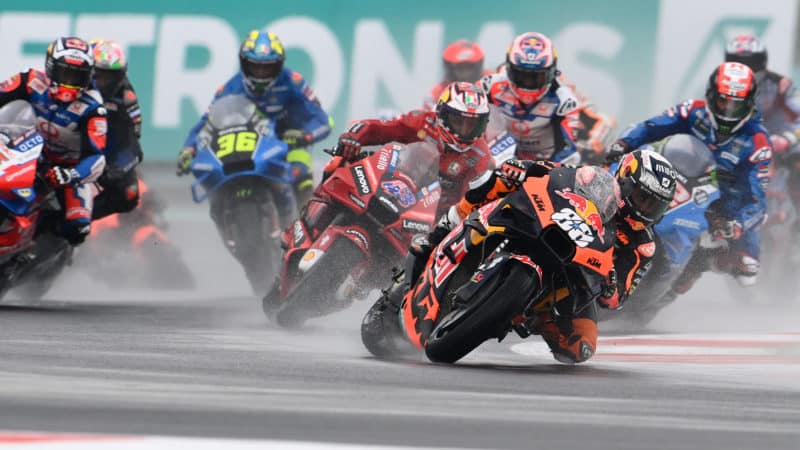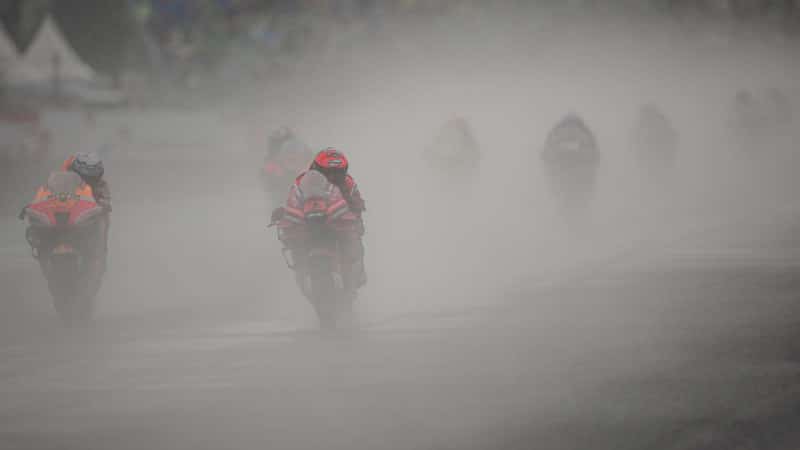Riders don’t like the tyre because it doesn’t give much grip or feeling, hence many falls during Indonesian GP practice, which made you wonder how safe this safety tyre really was.
Whenever tyres are changed there are always winners and losers. But that’s not the point. MotoGP’s six manufacturers design their motorcycles around the tyre specifications provided by Michelin, following extensive testing with all the factories. Each machine is then specifically tailored to fit those tyres.
When Michelin designed its 2020 rear slick the company knew that MotoGP goes racing in the tropics and was likely to increase its presence in South-East Asia – where the people adore motorcycles – so why design a tyre than can’t handle extreme heat? Or am I over-simplifying the task of creating a tyre that can cope with 300 horsepower and 60-degree track temperatures? Almost certainly.
The problem during the Mandalika tests was the softer casing, which flexes to increase the contact patch, which delivers more grip. But flex also increase heat build-up, which was a big problem at MotoGP’s newest venue, which features 17 corners and barely a straight in its 2.7 miles/4.3km.
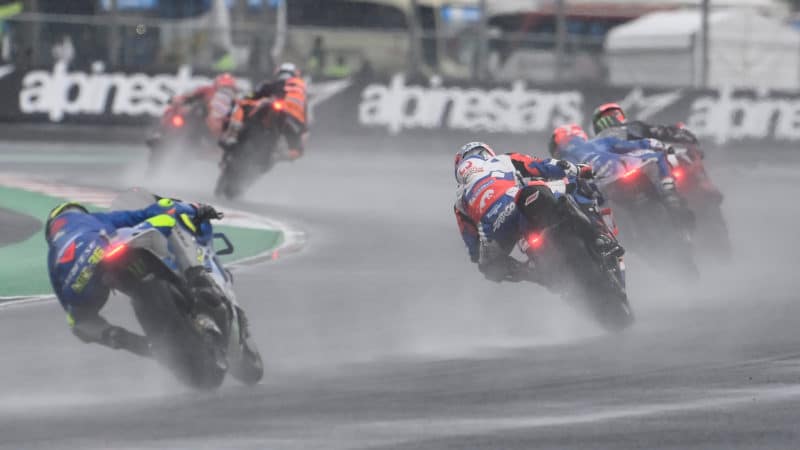
Leaders Miller and Oliveira chased by Quartararo, Rins, Zarco and Mir
Red Bull
Fitting the super-stiff 2018 rear slick sent several riders into a spin, both figuratively and literally.
Honda and Suzuki suffered worst with the tyre, Aprilia, Ducati and KTM did OK, while Ducati seemed in some ways to benefit from the stiffer casing.
Most riders seemed to agree that their main worry with the ‘safety’ casing was lack of grip on corner entry. On Saturday evening Joan Mir was adamant that he wouldn’t finish the race with the tyre.
“For me the biggest problem is going into the corners – I don’t have the grip to go in fast, the rear always wants to come around,” said Suzuki’s 2020 world champion. “Riding in these conditions I won’t be able to finish the race. Honestly, I think I will crash, because I’m riding too much on the limit in every corner.”
The monsoon-like rains saved Mir from that eventuality, but they arrived too late to save Marc Márquez.
The six-time MotoGP world champion is starting what will hopefully be his first full racing season since 2019. The injuries he suffered during the past two years ended Honda’s reign as MotoGP kings and convinced HRC to totally redesign the RC213V, transforming it from a front-end machine to a rear-end machine, to take full advantage of the grippier rear slick, standard fitment since 2020
Friday wasn’t too bad for Márquez. “The stiff casing affects the rear contact [between tyre and asphalt], so there is less grip and less warning,” he said. “I had a few moments in FP2. It’s the character of the tyre and we need to understand where the rear floating comes from.”
Saturday and Sunday got much worse for the 29-year-old. Outside the top ten after FP1, 2 and 3 he had to try to make it through Q1 into Q2 to have a chance of starting from better than the fifth row. Therefore on Saturday afternoon he was in full-attack mode, never mind the fact that his bike/tyre combination wasn’t really up to the job. He crashed twice in the 15-minute session, losing the front on both occasions.
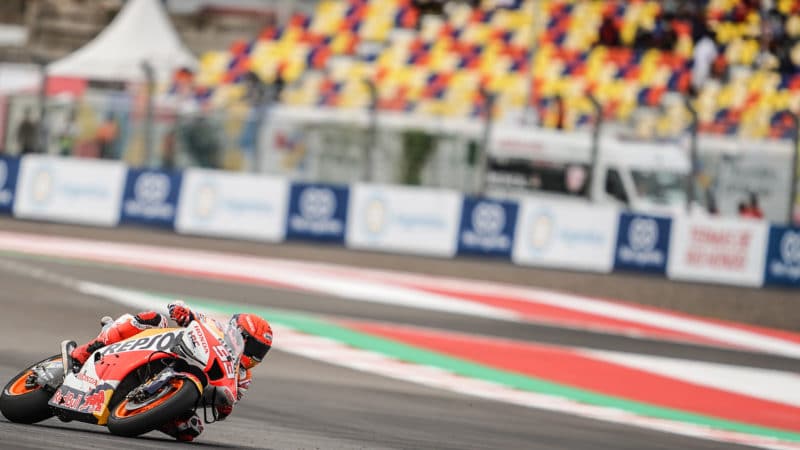
Márquez gave it his all – too much in fact, especially in Sunday morning warm-up.
Honda
“I tried when it wasn’t possible,” he admitted. “When we rode in the tests here all the Honda guys rode very well, then when we arrived this weekend we started to struggle a lot with the rear, so we started pushing more with the front tyre.
“Of course we all have the same tyre, so everyone is in the same situation, so we need to understand how to find a way to take profit of the tyres.
“This is a tyre with which I’ve won races in past, but now the bike is different. And Fabio [Quartararo] did similar times in the tests, so the performance is there.”
Marquez did indeed win the race when this super-stiff slick was last deployed. That was the 2018 Thai GP at Buriram, when he won a long duel with Andrea Dovizioso’s Ducati.
Most significantly that day saw a resurgence from Yamaha, which hadn’t really got close to winning a race all season. The stiffer casing worked wonders with the YZR-M1, allowing Maverick Viñales to catch the leaders and take the chequered flag just two tenths down, with factory team-mate Valentino Rossi close behind. And unlike Honda, Yamaha hasn’t reinvented the M1 since.
Quartararo took pole position at Mandalika, but the front two rows were dominated by Ducatis – four of the fastest six riders were on GP22 and GP21 machines because the stiffer slick gave the super-powerful Desmosedici more stability.
Factory Ducati rider Jack Miller explained the situation… “Through the three fast corners – five, six and seven – when you’re at full lean, trying to go to full gas and hitting kerbs and all sorts of things that stiffer casing definitely gave me a lot more stability, a lot more confidence to hang off the bike more, in general a lot less pumping from the rear.
“A lot of the time at other tracks we have issues with the rear of the bike pumping with the current casing and I feel that’s 100% coming from the rear tyre. For sure the performance of the stiffer casing isn’t as good as something that’s softer, more malleable and gets nice and hooked up, but you need to find a compromise, I guess.”
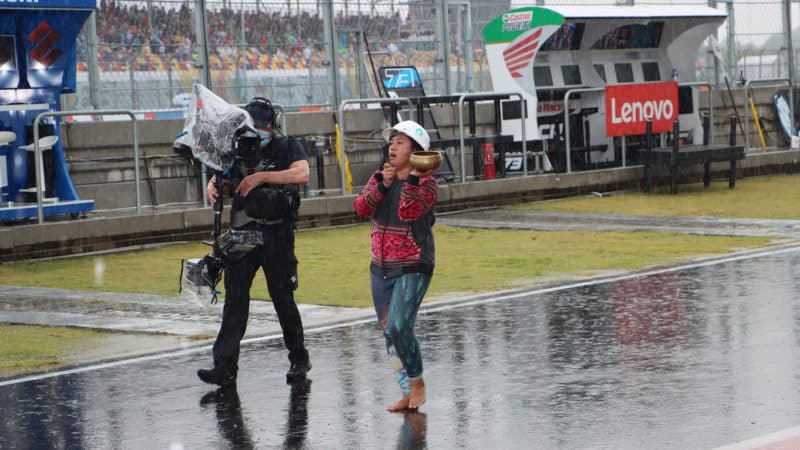
Mandalika’s shaman in pit lane, during the pre-MotoGP race delay, but was she incantating for sun or rain?
Oxley
Of course the man who suffered most due to the 2018 tyre was Márquez. During Sunday morning warm-up he was again on the limit, trying to find the speed he so desperately needed if he was to compete for the podium.
His biggest problem had been a lack of rear grip entering corners, where traction control and cleverly mapped torque-demand maps cannot save you.
When he attacked the high-speed Turn 7 the rear tyre slid, regained grip and flung him a good two or three metres into the air. If his previous Q1 crashes had been risks worth taking, this wasn’t. It was warm-up and a wet race was strongly predicted.
Márquez was lucky to escape with a vicious battering and bruising and concussion, which ruled him out of the race.
And that’s what can happen when you fit a 2017/2018 rear tyre to a motorcycle that’s specifically designed to work with an entirely different 2022 rear tyre.
In fact Michelin shouldn’t alone be blamed for this situation. Allowing MotoGP bikes to test at a brand-new track, in a part of the world where asphalt and tyre problems are always likely, just a few weeks before the race isn’t really good enough. Therefore MotoGP – and Márquez in particular – were a victim of circumstances.
And yet the championship came so close to robbing itself of its biggest star that the people in charge should work harder than ever to make sure that this kind of thing – last-minute tests, emergency tyres and so on – doesn’t happen again.
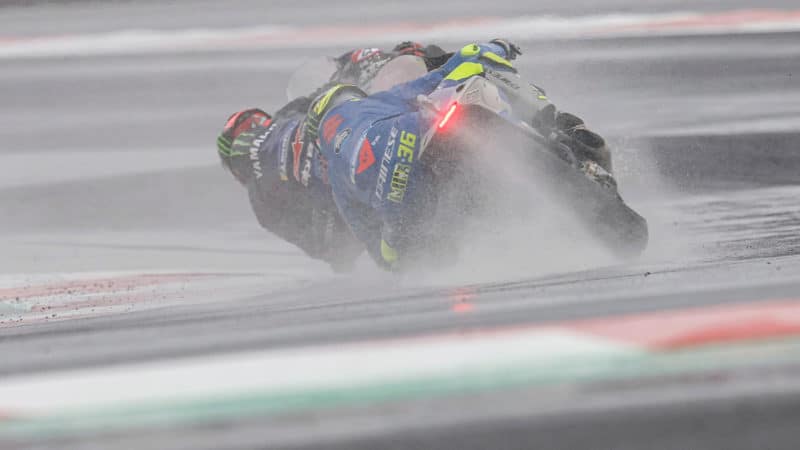
Knees and elbows on the soaking and super-grippy asphalt, Mir chases Morbidelli
Suzuki
Finally, it was just as well that the Mandalika shaman wasn’t very good at her job. The rain-lashed race – run on current-spec rain tyres – was full of entertainment, with winner Miguel Oliveira making it look easy, while the rest of the pack fought among themselves.
MotoGP may have lost The Doctor but it’s gained a dentist, who went to work with the kind of precision you’d like your own tooth doctor to use.
Of course, being out front made more sense than ever – the 27-year-old Portuguese led the first lap, then the fifth to the last – because most of the riders behind him complained that it was almost impossible to see due to the spray and the dirt thrown up by the new asphalt.
“I couldn’t see anything,” said world champion Fabio Quartararo, who started well, then dropped back, before understanding just how much grip was available, so he pushed forward again to take second from Johann Zarco and Miller, who were scrapping for the final podium position.
“Miguel felt confident,” said his Red Bull KTM crew chief Paul Trevathan. “After Qatar he was super-disappointed in himself after another DNF through a crash, so he came here fired up to show us what he could do it. Remember KTM got our first podium in the wet, so he was super-confident and managed the situation well.”
Despite the soaking-wet race there was only one crash, Jorge Martin who locked the front into Turn 1. According to the earlier comments of Mir and others there may have been many more fallers with the ‘safety’ tyre in the dry.
Next time out at Termas de Rio Honda, Argentina, less than two weeks from now, Michelin will return to its normal 2022 tyre allocation and hopefully Márquez will be fit enough to use it.
